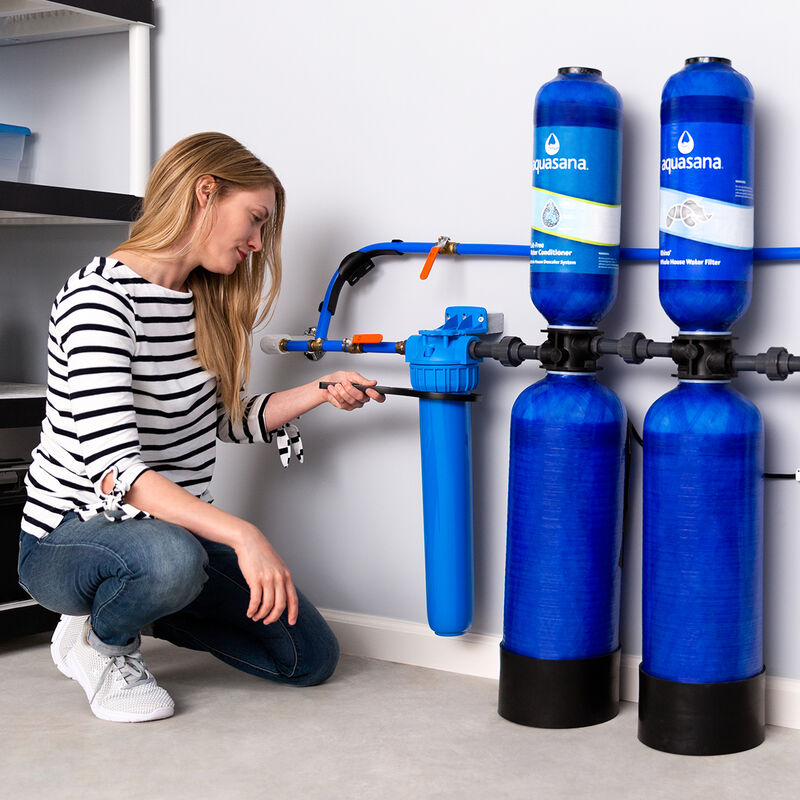
The whole reason that I started creating a healthier home has snowballed from simply learning about healthier water. I had just finished an environmental science class and our home was in the process of converting from potentially contaminated well water over to city water. I knew that there were many filter options from whole house water filters to pitcher filters.
I didn’t know where to start with all of it. I had learned so much about how well water can easily become contaminated through the agricultural farms around us and the large companies mass producing our products. But I also knew that city water also had contaminants and disinfection byproducts in it that weren’t healthy for my family either.
I took what I knew and began researching ways to make my water healthier and remove the contaminants. From there I slowly began to see that water wasn’t the only issue. It was a big issue, and it was an important one, but the toxins in our house are in so many materials and products we bring in.
I personally feel like water is one of the FIRST places anyone should start if they have the budget to do so. Because water is something we consume and cook with, it can have a greater impact on your health and wellness.
Here’s what you’ll find in this week’s blog post:
- Who needs a whole house water filter
- How Chlorine impacts your health
- How a whole house filter benefits your healthy house and your health
- How it’s different than a point of use filter; and
- My healthy house approved whole house water filters

WHO NEEDS A WHOLE HOUSE WATER FILTER?
Personally, I think everyone could benefit from a whole house water filter. Because a whole house filter will remove chlorine and chlorine byproducts from the water in the entire home, it will benefit not only your health, but also your plumbing.
City water often adds chlorine as a disinfectant, but even though the process of cleaning the water does remove SOME of the chlorine, there are still trace amounts of chlorine and chlorine byproducts that are so harmful to our bodies left in the water.
You might think that if you get your water from a well you’re in the clear. Unfortunately, that is not the case. Well water can contain bacteria as there are no disinfectants used on the water. This bacteria can breed inside your pipes and if you’re not careful, in your water heater.
A whole house water filter add-ons remove up to 99.99% of viruses and bacteria in the water, leaving your pipes in a completely healthy state.

ISN’T CHLORINE SAFE FOR WATER CONSUMPTION?
As I’ve talked about before with other contaminants, there are three ways we come in contact with chlorine in drinking water.
The first is ingestion. This is the most obvious way we come in contact with this contaminant as we consume and drink water on a regular basis as well as cook with it. Consumption of chlorine in drinking water may look different depending on WHO is consuming it. Obviously as adults our bodies can handle larger amounts of chlorine in drinking water in comparison to an infant who is drinking formula made with chlorinated water.
This also is something to keep in mind, as always, if you have kids or babies, their risk of these health effects will be much greater than the risk of a healthy adult.
Consuming drinking water with chlorine has been shown through multiple studies to increase the risk of bladder cancer. It has also been linked to breast cancer and bowel cancer. (STUDY) Other non cancerous effects of chlorine in water leads to irritation of the liver and intestinal tissue.
Another side effect of chlorinated water? Weakened teeth and increased tooth decay. The chlorine appears to corrode teeth due to the hydrochloric acid that is formed and can also cause inflammation to the lining of the mouth (STUDY)

A series of studies performed from 2008 – 2016 also linked chlorine in drinking water to an increased risk of birth defects when consumed by pregnant mothers including heart problems, cleft palate, brain abnormalities and even increase in miscarriages and still born babies. (STUDY)
Another way that we come into contact with chlorine through a water source is through both inhalation and absorption. This is most common when we shower or bathe in our unfiltered water at home. Believe it or not, the inhalation of chlorine in drinking water during a hot shower can be JUST as detrimental to health as consuming it. The chlorine byproducts that end up in the water vapor while showering are 100 times more frequent than drinking the same water. The body actually absorbs the volatile chemicals during bathing which increases health risks in several areas.
The first area that chlorinated water can exponentially affect health is the respiratory system. Obvious issues would be inflammation and irritation to the nose and throat membranes. But it also affects the lungs and can trigger bronchial asthma as it allows the passage of allergens. Increased risk for asthma and allergies is a main concern when it comes to inhalation of water. (STUDY)
Skin and hair are also areas of our bodies that can really be damaged by the effects of chlorine in drinking water. Chlorine strips the skin of normal oils and can cause rashes and drying in both hair and skin. But chlorine can also advance the age of free radicals inside the body, mainly the skin. This can increase the risk of melanoma and skin cancer. It also advances the process of aging skin. (STUDY)
WHAT ARE THE BENEFITS OF A WHOLE HOUSE FILTER?
Chlorine Free Showers: While chlorine has been deemed safe with many agencies and municipalities, it actually does cause issues, even in small, daily doses. If you have a point of use filter, you may be missing filtered water at your bathtub spout and shower head. This means you can be breathing in chlorine vapors and absorbing chlorine in your skin, both of which are harmful to your internal health and skin health.
Brush Your Teeth In the Bathroom: If you brush your teeth in the bathroom, but don’t have the water filtered, again, you’re being exposed to potentially chlorine or bacteria. While oftentimes we don’t necessarily consume this water, chlorine has been shown to negatively impact tooth enamel. And we’re still coming in contact with either chlorine or bacteria.
Reduce Bacteria in Plumbing & Water Heater: A huge concern with water that may contain bacteria is that the bacteria can breed in your piping, inside fixtures and inside your water heater. While the idea of a water heater is to kill bacteria with hot heat, many homes don’t keep their water heaters up to the recommended 120 degrees that is required to kill bacteria. And it still doesn’t address water sitting inside areas of a faucet or the drains, where the bacteria can then breed. A whole house filter uses a UV light to reduce this bacteria and leaves you with healthier pipes.
Seals Don’t Crack in Fixtures: One thing that I noticed in a big way after we went from well water to city water was that our seals in our faucets and fixtures didn’t last very long. The chlorine from the water broke down the rubber seals and left them cracked, meaning they began leaking. By removing chlorine from your water, you can preserve your seals and prevent faucets from leaking on a frequent basis.
Better Smelling & Tasting Water: Let’s face it, both bacteria and chlorine are not scents that most of us like, and they’re not pleasing to the taste buds either. It can be very obvious that a home has minerals in the water based on the smell and taste too. Have you ever visited a rural area where the iron levels were really high? It’s difficult to drink the water and bathe in it, even if it is just iron. A whole house filter will help remove all three of those contaminants, leaving you with water that tastes great and smells great.
Longer Lasting Appliances: A whole house filter will not only remove contaminants, but also minerals that are hard on your appliances. Hard water can take a huge toll on appliances like dishwashers, washers and water heaters. Not to mention, if you have city water, the chlorine can damage and age the seals on those appliances too. Washing machine seals and dishwasher seals are a very important part of the appliance working properly.

CAN’T I JUST USE A POINT OF USE FILTER?
Yes, I suppose you could use a point of use filter. And let me also say, if you’re not in a position to purchase or invest in a whole house filter, and you can get a less expensive point of use filter, you should still go that route.
But, if you can work a whole house filter into your budget, there are a few reasons that it can make a bigger impact on your home.
First, you can increase the filter life with a current point of use filter if you have a whole house filter. The whole house filter is doing some of the work, and so not as many contaminants will be going through your point of use filter. This means that your filter will last longer and need to be replaced less frequently.
Second, your point of use filter is great for cooking and drinking water from a specific faucet, but it misses filtering other faucets and showers and tubs in your home. Without filtering water to these areas, you’re possibly consuming or absorbing toxins due to unfiltered water.

WHAT ARE YOUR HEALTHY HOUSE APPROVED WHOLE HOUSE WATER FILTERS?
My FAVORITE whole house filter for the last several years has been Aquasana. I recommend them to all my consultation and inspection clients as a high quality option that will also leave them with healthier water.
The Rhino Max Flow is best for those looking to remove chlorine or chloramines from water throughout the entire home (and is ideal for those living in a larger home or people seeking maximum performance). They also have system upgrades for the Rhino Max Flow like our Salt-Free Water Conditioner that naturally and safely reduces scale buildup on internal pipes and plumbing without the use of salt or chemicals, and our optional UV Filter to sterilize 99.99% of bacteria and viruses.
It also comes with:
- The standard pre-filter needs to be replaced every 2 months, but we now offer a low-maintenance pre-filter that only needs to be replaced every 6 months
- The post-filter needs to be replaced every 6-months
- If you have a UV lamp upgrade, that needs to be replaced every 12 months
- The tank itself only needs to be replaced every 10 years or 1,000,000 gallons






Pingback: 8 Ways to Transform Your Healthy Home & Support Your Health